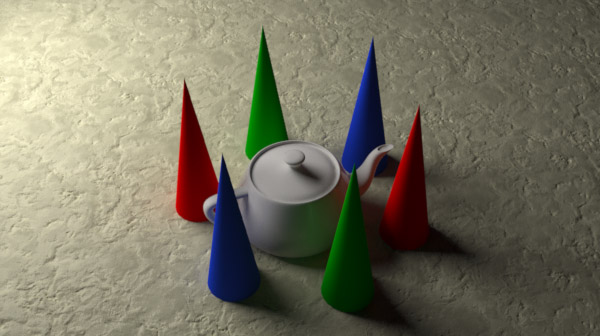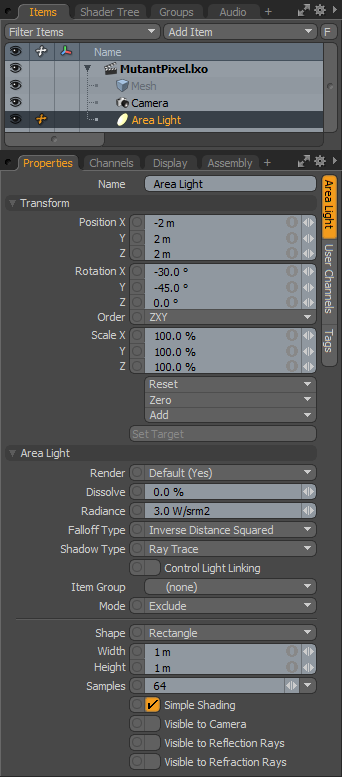
The Area Light is similar to a studio soft box style light, often used in professional photography because of the soft shadows they produce. Light comes from a square or round plane depending on the light settings. Area lights are excellent for creating photo realistic lighting effects as they create a very natural light emission and smooth shading. They are typically more expensive, render time wise, than other light types because they require more samples due to their size but their natural tendency to create soft edged shadows is worth the trade-off in many situations. Area Lights use a physically accurate light model so the intensity of the light falls off with the inverse square of the distance to the light, for example a surface will be half as bright when the light is twice as far away. As a physically based light, the intensity is also increased as the volume (size) of the light increases. Increasing the size of the light relative to the models it affects will also increase the amount of shadow spread. Options for the Area Light include Position, Rotation, Scale as well as Radiance, Shadow Type, Samples, Sample and Area Width/Height. When adjusting the Area Light in the 3D view be sure to use the Item Transform tool. This will provide additional handles so you can adjust the length and width of the light directly in the 3D viewport. To control the lights color, shadow color and other material related properties, refer to the Light Material page of the documentation.
Area Light
 Name: This data field displays the current item name. Users may easily change it by LMB-clicking within the field and typing the new name.
Name: This data field displays the current item name. Users may easily change it by LMB-clicking within the field and typing the new name.
Transform--
Position: An Item transform that allows the user to numerically position the light item in XYZ space. By default, Position transforms originates from the items center position.
Rotation: An Item transform that allows the user to numerically set the rotation of the light item. By default, Rotation transforms originates from items center position.
Order: Allows the user to set the order that rotations are applied to the light item. Changing the order that rotations are applied can sometimes help to reduce or eliminate gimbal lock.
Scale: An Item transform that allows the user to numerically set the size of the item. This scale transform is a multiplier of the Height and Width options.
Reset: Resets the selected transform values to (0,0,0) returning the items back to the world space center position.
Zero: Returns the light items Center position to the world space center (0,0,0) without changing the position of the light item itself.
Add: The 'Add' function will add the selected set of transforms to the channel list. Useful when animating complex motions, providing a layered approach to the transforms.
Set Target: By selecting the Light item, and a single additional item in the item list, and then pressing 'Set Target', this function allows users the ability to target specific items in a scene, automating the rotation of an item, so that it continuously points toward the targeted item. Once activated, additional option appear--
Remove Target: Removes the target link between the two items.
Enable: Toggling this option off temporarily disables the targeting function while retaining the link between the items.
Set Focus Distance: This option sets the focal distance for DOF when targeting camera items to other item.
Roll: Provides the ability to offset the items rotation angle away from the target.
Time Offset: Provides users the ability to time offset, by a number of frames, how the light follows the target item. It can either be delayed behind it with a negative value, or run ahead of it with a positive value.
Area Light--
Render: This drop down menu allows the user to select from 3 choices, when set to 'Default', the user can enable/disable lights using the visibility function "![]() " of the item list. When the light is visible, it contributes to the final rendered scene and when invisible, it will not. On some instances the user may prefer to fix this state, setting the light as 'On' (enabled) or 'Off' (disabled) regardless of visibility. Also useful for workflows that auto toggle visibility, saving the user from manually enabling lights for test renders.
" of the item list. When the light is visible, it contributes to the final rendered scene and when invisible, it will not. On some instances the user may prefer to fix this state, setting the light as 'On' (enabled) or 'Off' (disabled) regardless of visibility. Also useful for workflows that auto toggle visibility, saving the user from manually enabling lights for test renders.
Dissolve: When the 'Dissolve' function is set to any value above 0%, the lights overall affect on the scene will attenuate as the value increases. When set to 100%, the lights effect on the scene is completely disabled. This function providing a convenient way to dim a lights effect on your scene.
Radiance: This value controls the intensity of the light and uses the Watts per steridian per square meter. As you would expect, increasing this value will increase the apparent brightness of the Area Light and decreasing the value reduces the lights intensity. Area light shading is calculated from the size and shape of the light, so larger lights will produce more illumination in the scene than smaller ones will and adjustment will be necessary when scaling the size of the light.
Falloff Type: Light in the real world isn't a uniform brightness, its intensity diminishes with distance. Photographers will be familiar with the concept that a light will be a quarter as bright at twice the distance away, know as the Inverse Square Law. modo lights default to this setting providing a realistic way to light a scene, however there are times when users may not wish to have this behavior, so modo provides three falloff type options-
None- No falloff, light is consistently bright across its distance.
Inverse Distance- Light is half as bright at twice the distance.
Inverse Distance Squared- Default behavior, Light will be a quarter as bright at twice the distance.
Shadow Type: This popup offers options between 'Ray Traced' , 'None' and 'Deep Shadow Maps'. In situations where users want a light to cast a shadow, Ray Traced will give the most accurate results. Deep Shadow maps are useful for volumetric lights and fur rendering, where a great deal of calculations are required to produce shadows; producing similar results to ray traced shadows while reducing the number of calculations.
Control Light Linking: Illumination on a surface is generally controlled by the 'Shader' item in the Shader Tree. Within the Shader it is possible to control a lights affect on a surface with Light Linking. As its name describes, it links the illumination affects of a Group of Lights to specific Items or Material Groups. When the 'Control Light Linking' option is enabled on a Light item, it will act as an individual Light Specific override to the Shader, allowing users to 'Include' or 'Exclude' a specific lights illumination on a group of items.
Item Group: The 'Item Group' option determines the specific Group of item layers in the scene that will be affected by the Light Linking. The Group needs to be defined in the Groups viewport panel. This can be done easily by selecting the target items while in 'Items' mode and then in the Groups palette LMB+click the 'New Group' button. Define a name for the group in the pop-up dialogue and choose the 'From Selected Items' option and click 'OK' to accept. Once the Group is defined, select the named group here.
Mode: The 'Mode' option determines whether the light will be 'Included' meaning it will only affect the Items in the specified Item Group, and 'Excluded' by all other surfaces, meaning it will be ignored by any items in the specified Item Group.
Shape: Area lights can be specified as 'Rectangular' or 'Elliptical'. The shape of the light will slightly impact total distribution of light.
Width/Height: These values set the size for the light as an absolute value for width and height and is based on the current units. By default the unit system is Metric so the width and height would be set directly as meters. When the light item is selected in the 3D viewport, additional handles are available allowing users to interactively scale the area light item. Keep in mind that the size of the light affects the apparent intensity as mentioned above.
Samples: As the size of the area light increases, so does the soft edge spread of the shadow. If the resulting shadows appear grainy, additional samples may be required to smooth out the results. The default value of 16 is a good starting point for balancing speed and quality. One may also need to increase the number of samples as image resolution increases, keeping in mind that increasing the number of samples will also increase the render time.
Simple Shading: With the 'Simple Shading' checkbox enabled, modo will calculate the specular and diffuse values for a surface as if the area light were a single point, regardless of the width and height. However, with 'Simple Shading' disabled, modo uses the same light array as the shadow to calculate the specular and diffuse values. This results in diffuse and specular shading that is 'soft', like the shadow but can also become increasingly grainy with a lower number of samples. Increasing the number of 'Samples' will reduce grain in the diffuse and specular shading as well as the shadows at the expense of longer render times.
Visible to Camera: Users can enable this option to make the Area Light itself visible to cameras. The size and shape of the visible plane is determined by the 'Shape', 'Width' and 'Height' attributes of the light.
Visible to Reflection/Refraction Rays: Users can enable either or both of these options to make the Area Light itself visible to reflective and/or transparent surfaces. The size and shape of the visible plane is determined by the 'Shape', 'Width' and 'Height' attributes of the light.


